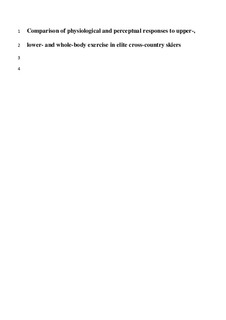| dc.description.abstract | Undebakke, V, Berg, J, Tjønna, AE, and Sandbakk, Ø. Comparison of physiological and perceptual responses to upper-, lower-, and whole-body exercise in elite cross-country skiers. J Strength Cond Res 33(4): 1086–1094, 2019—The primary purpose of the present study was to compare physiological and perceptual responses to maximal and submaximal exercise between upper-, lower-, and whole-body exercise modes in elite cross-country (XC) skiers. Twelve elite XC skiers performed 5–7 submaximal 5-minute stages and an incremental test to exhaustion using upper-body poling (UP), running (RUN), and diagonal skiing (DIA), randomized on 3 separate days. Here, power output, cardiorespiratory variables, heart rate (HR), blood lactate concentration (BLa), and rating of perceived exertion (RPE) were determined. Peak power output increased gradually from UP to RUN and DIA, whereas peak oxygen uptake (V[Combining Dot Above]O2peak), peak HR, O2pulse, and total RPE were clearly lower in UP than RUN and DIA (p < 0.05). At submaximal workloads matched for either RPE, %HR, or BLa, the main pattern was that BLa was higher and V[Combining Dot Above]O2 and HR lower in UP compared with RUN and DIA (p < 0.05). DIA showed ∼10 and 35% higher V[Combining Dot Above]O2 than RUN and UP at RPE 10–13 and had lower muscular RPE values than UP and RUN at a given % of peak HR (p < 0.05). Most of the differences in cardiorespiratory variables between modes were eliminated when they were normalized to V[Combining Dot Above]O2peak or peak HR in the respective mode. Because of the low power production in UP, endurance training in this mode exhibits too low values of V[Combining Dot Above]O2 to tax the cardiovascular system sufficiently. In RUN and DIA, the similar V[Combining Dot Above]O2peak values indicate that both modes can be effectively used during high-intensity training and to determine V[Combining Dot Above]O2max in elite XC skiers. However, the relatively high V[Combining Dot Above]O2 values at low perceptual stress with submaximal DIA indicate that the large amount of power produced when combining upper- and lower-body work exhibits high oxidative flux even during low-intensity training. Overall, these findings should be taken into account when athletes and coaches are monitoring and prescribing training in future approaches, in particular in sports where athletes vary between training with upper-, lower-, and whole-body exercise modes. | nb_NO |
